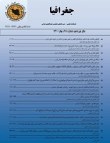Evaluating the Level of Vulnerability of Urban Infrastructures with a Passive Defense Perspective (Case study: Shirvan- Northeastern Iran)
Urban facilities, some of which include vital and sensitive infrastructures of the country and national capital, and the other include production, distribution and provision of municipal services such as city water source and reservoir, city electricity facilities, telecommunication center, gas facilities, emergency, fire station, etc. are among the public spaces of the area and city which are built and operated at a high cost and are directly related to other functions of the city, so that any disturbance in them paralyzes other urban functions. As a definition, the passive defense is a set of measures that do not require the use of weapons, equipment and weapons, and by implementing it, it is possible to prevent financial damage to vital, sensitive and important military and civilian equipment and facilities, and human casualties, or decrease the amount of damage and casualties caused by air strikes and missile bombardments to a minimum. Shirvan, as the second big city of North Khorasan province and because of the localization of management centers, vital and important facilities in it is of great importance. In addition, the city of Shirvan could face political and military threats due to its proximity to Turkmenistan. Therefore, it is necessary to pay attention to the vulnerability and endangerment of urban facilities and equipment of Shirvan from the point of view of passive defense, which according to the issues raised, the most important question of the present study is: Which category of urban elements in Shirvan are the most important elements vulnerable to human hazards? Therefore, considering the role and position of Shirvan city and also based on the general policies of the Iran system regarding passive defense of the country, acted by the Expediency Discernment Council of Iran, planning and formulating strategies to improve its security is of high importance. The purpose of the present study was to evaluate the level of vulnerability of the (vital, sensitive and important) elements of Shirvan city against the military threats with passive defense approach.
Due to the nature of the data, the present study uses a mixed research method. Also, this research from the perspective of purpose is an applied research and in terms of research method was a mixed method of descriptive, analytical and field research method. After identification the location of vital, sensitive and important centers in this city, Analytical Hierarchy process (ANP) and GIS software were used in order to evaluate these centers. Considering that the statistical population of the present study included managers and experts specializing in passive defense and urban planning, and based on information obtained from departments and organizations related to the research topic, namely, municipality, governorate, road and urban planning office, Red Crescent department and military organs, which were about 80 persons. Then, 50% of the statistical population ie 40 experts and thinkers in the field and related to the research topic who were working in the city of Shirvan were selected a statistical sample and a specialized questionnaire that completed by these individuals was analyzed using the ANP model. In the present study, three main criteria (vital centers, sensitive centers and important centers) along with sub-criteria with the opinion of relevant experts were extracted and listed as important elements and areas of Shirvan city.
Due to the strategic position of Shirvan city and having a common land border with Turkmenistan, the study of its vulnerability is of particular importance and the importance of planning in times of crisis is felt in the research area. Based on the results, the number of 13 sub-criteria in 3 criteria of vital, sensitive and important centers were combined with each other in ArcGIS software and based on the importance coefficients obtained by experts and elites in Super Decisions software. The following figure shows the vulnerability of Shirvan city in the face of natural and human hazards using ANP Analytic Network Process, and based on passive defense approach. The results showed that the study conducted by Anvari et al (2020) in Zahedan (Souteastern Iran) is consistent with the present study, because in Zahedan, the largest area of the city showed less vulnerability. Also, the results of Aftab et al. (2018) in Urmia (Northwestern Iran) was consistent with the results of the present study because in Urmia the vulnerability of urban elements was low. on the other hand it was not consistent with the results of research conducted by Khodadad et al. (2019) in Bandar Torkman (Northern Iran), because in their research 75% of the Bandar Torkman has been exposed to high vulnerabilities.
Vulnerability rate in 11.6% of Shirvan city is very low, 41.3% has low vulnerability rate, 25.9% moderate vulnerability rate, 17.2% high vulnerability rate and 3.9% is with very high percentage of vulnerability. In fact, it can be said that the vulnerability of Shirvan is low in 52.9% of the city and high in 21.1% of the city. In the central neighborhoods of the city, due to high age, population density, dilapidation, low quality of buildings, etc., the level of vulnerability is high. Therefore, with the obtained results, it can be said that the vulnerability of land uses in Shirvan is low.
- حق عضویت دریافتی صرف حمایت از نشریات عضو و نگهداری، تکمیل و توسعه مگیران میشود.
- پرداخت حق اشتراک و دانلود مقالات اجازه بازنشر آن در سایر رسانههای چاپی و دیجیتال را به کاربر نمیدهد.


